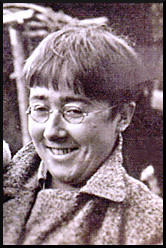Felicia Browne facts for kids
Quick facts for kids
Felicia Browne
|
|
|---|---|
 |
|
| Born | 18 February 1904 Weston Green, Surrey, England
|
| Died | 25 August 1936 (aged 32) Aragón, Spain
|
| Alma mater |
|
| Known for | Painting, political activism, being the first British person to die in the Spanish Civil War |
| Awards | Tolpuddle medal |
Felicia Mary Browne (born February 18, 1904 – died August 25, 1936) was a talented English artist. She was also a strong believer in social justice. Felicia became the first British person, and the only British woman, to die fighting in the Spanish Civil War. Her body was never found.
Contents
Early Life and Art School
Felicia Mary Browne was born in Weston Green, Surrey, England, on February 18, 1904. She was one of five children. Her mother, Edith, was an actress, and her father, Harold, worked in advertising.
Felicia loved art from a young age. She studied at the St John's Wood Art School. Later, she attended the famous Slade School of Art between 1920 and 1928. She was very young when she started at Slade, only 16 years old. There, she studied alongside other artists who would become well-known.
Career and Activism
In 1928, Felicia traveled to Berlin, Germany, to learn metalwork. She even became an apprentice to a stonemason. While living in Berlin, she saw the rise of Nazism, a political movement that was very unfair and violent. Felicia took part in activities against the Nazis. Some stories say she even joined street fights against them.
In the early 1930s, she returned to Britain. She had to leave her sculptures and tools behind in Germany. In 1931, she visited the Soviet Union. In 1933, she joined the Communist Party of Great Britain. This was a political group that believed in sharing wealth and power more equally. Because of her political activities, the British government kept an eye on her.
Felicia was also an active member of the Artists' International Association. This group brought together artists who wanted to use their art for social change. In 1934, she won an award for designing a medal for the Trade Union Congress in Tolpuddle. She also contributed her artwork to a magazine called Left Review.
Fighting in the Spanish Civil War
In July 1936, Felicia Browne went on a driving holiday to France and Spain. She was with her friend, Dr. Edith Bone, who was a photographer. They planned to reach Barcelona for the People's Olympiad. This was a sports event organized as a protest against the Olympic Games being held in Hitler's Berlin.
However, they arrived just before a military uprising began in Spain. This uprising started the terrible Spanish Civil War (1936–1939). Felicia and Edith were immediately caught up in the fighting in Barcelona.
Felicia was determined to help. On August 3, 1936, after trying several times, she joined the Karl Marx militia. This was a group of fighters linked to the Communist Party in Catalonia. She went to fight on the Zaragoza front in Aragon. A reporter named Sydney Smith said that Felicia insisted on joining the fight. She declared, "I am a member of the London Communists and I can fight as well as any man."
Death and Remembrance
On August 25, 1936, Felicia Browne was killed in action. This happened on the Aragón front, near a town called Tardienta. She was part of a small group trying to blow up a train carrying supplies for the opposing side, the Nationalists.
Her group was ambushed. Felicia was shot and killed while she was helping an injured Italian soldier. Her body could not be brought back. However, her fellow soldiers saved a sketchbook she had with her. It was full of drawings of her comrades.
These drawings were given to Tom Wintringham, a journalist. He suggested that the Artists' International Association (AIA) sell them to raise money to help people affected by the war in Spain. The AIA showed Felicia Browne as a brave artist who took direct action for her beliefs.
Her friend Nan Youngman was very sad about Felicia's death. She organized an exhibition of Felicia's art in October 1936 to remember her.
See also
 In Spanish: Felicia Browne para niños
In Spanish: Felicia Browne para niños
- Shapurji Saklatvala
- British Battalion
- Charlie Hutchison
- Bill Alexander
- Ralph Winston Fox
- Thora Silverthorne

